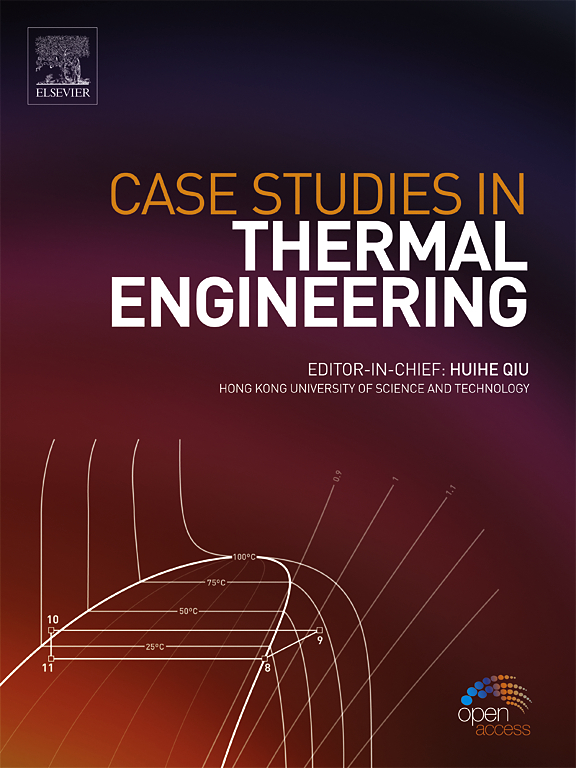Bridging the gap: A comparative analysis of indoor and outdoor performance for photovoltaic-thermal-thermoelectric hybrid systems
IF 6.4
2区 工程技术
Q1 THERMODYNAMICS
引用次数: 0
Abstract
This research evaluates the performance of a hybrid thermal-thermoelectric photovoltaic air collector system (PV/T-TE) through experimental investigations. By integrating photovoltaic (PV) panels with thermoelectric (TE) modules, the system aims to enhance efficiency and energy output by converting waste heat into additional electricity. The study examines the impact of radiation intensity, ranging from 455.65 to 795.18 W/m2, on the system's performance, utilizing output temperature (To) and plate temperature (Tp) as key metrics. Managing waste heat in PV technology remains a challenge, impacting efficiency. Traditional PV/T systems generate both electricity and thermal energy but suffer efficiency losses due to inadequate heat management. Integrating TE modules into PV/T systems offers a promising solution, but optimal configurations and performance impacts under varying conditions are underexplored. Limited research focuses on PV/T-TE hybrid systems, with most studies addressing PV-TE systems. The objectives of this research are to experimentally assess the impact of integrating TE modules on the thermal and electrical efficiency of PV/T systems under varying radiation intensities and air mass flow rates. The methodology involves setting up a PV/T-TE hybrid system, conducting experiments under controlled conditions, and analyzing key performance metrics. The study explores optimal TE module configurations and installation techniques to maximize heat transfer and electricity generation. Comparative analysis with conventional PV/T systems establishes the superiority of the hybrid system. Findings indicate significant benefits from incorporating TE modules, enhancing energy output and efficiency by maintaining optimal PV panel temperatures.
缩小差距:光伏-热电-热电混合系统室内外性能对比分析
本研究通过实验研究评估了热电混合光伏空气集热器系统(PV/T-TE)的性能。该系统将光伏(PV)面板与热电(TE)模块集成在一起,旨在通过将废热转化为额外的电力来提高效率和能量输出。研究利用输出温度(To)和板温(Tp)作为关键指标,考察了辐射强度(455.65 至 795.18 W/m2)对系统性能的影响。光伏技术中的余热管理仍然是一项挑战,会影响效率。传统的 PV/T 系统既能发电又能产生热能,但由于热量管理不足而导致效率损失。将 TE 模块集成到 PV/T 系统中提供了一个很有前景的解决方案,但最佳配置和不同条件下的性能影响还未得到充分探索。针对光伏/TE 混合系统的研究有限,大多数研究都是针对光伏-TE 系统。本研究的目标是通过实验评估在不同辐射强度和空气质量流量条件下,集成 TE 模块对 PV/T 系统热效率和电效率的影响。研究方法包括建立光伏/TE 混合系统,在受控条件下进行实验,并分析关键性能指标。该研究探讨了 TE 模块的最佳配置和安装技术,以实现传热和发电的最大化。与传统 PV/T 系统的对比分析证明了混合系统的优越性。研究结果表明,采用 TE 模块具有显著优势,可通过保持最佳光伏板温度来提高能量输出和效率。
本文章由计算机程序翻译,如有差异,请以英文原文为准。
求助全文
约1分钟内获得全文
求助全文
来源期刊

Case Studies in Thermal Engineering
Chemical Engineering-Fluid Flow and Transfer Processes
CiteScore
8.60
自引率
11.80%
发文量
812
审稿时长
76 days
期刊介绍:
Case Studies in Thermal Engineering provides a forum for the rapid publication of short, structured Case Studies in Thermal Engineering and related Short Communications. It provides an essential compendium of case studies for researchers and practitioners in the field of thermal engineering and others who are interested in aspects of thermal engineering cases that could affect other engineering processes. The journal not only publishes new and novel case studies, but also provides a forum for the publication of high quality descriptions of classic thermal engineering problems. The scope of the journal includes case studies of thermal engineering problems in components, devices and systems using existing experimental and numerical techniques in the areas of mechanical, aerospace, chemical, medical, thermal management for electronics, heat exchangers, regeneration, solar thermal energy, thermal storage, building energy conservation, and power generation. Case studies of thermal problems in other areas will also be considered.
 求助内容:
求助内容: 应助结果提醒方式:
应助结果提醒方式:


